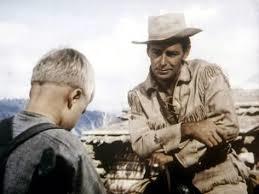A “Save the Cat” Moment
If you’ve read many of these posts, you know that I’m a big fan of screenwriting guru Blake Snyder and his book on the film writer’s craft, Save the Cat. Here is Blake defining this principle:
Save the Cat is the screenwriting rule that says: “The hero has to do something when we meet him so that we like him and want him to win.” Does this mean that every movie we see has to have some scene in it where the hero gives a buck to a blind man in order to get us onboard? Well no, because that’s only part of the definition.

Alan Ladd as Shane establishes tension in a “Save the Cat” moment with Brandon deWilde as Joey
So on behalf of my hypercritical critics, allow me a mid-course addition [Snyder goes on to cite Quentin Tarantino’s intro scenes in Pulp Fiction, in which the killers Vincent and Jules (John Travolta and Samuel Jackson) are without redeeming moral virtues but at least are funny and charming]: The adjunct to Save the Cat says: “A screenwriter must be mindful of getting the audience ‘in sync’ with the plight of the hero from the very start.”
Let’s examine this concept (which applies equally well, I believe, to the writing of novels and all other forms of storytelling).
Consider the opening of the classic 1953 Western, Shane.
The hero Shane (Alan Ladd) enters a Wyoming valley on horseback. He’s alone, riding at an easy, unhurried pace. He approaches a homestead. Six-year-old Joey (Brandon deWilde), the child of this ranch, keenly observes Shane’s approach.
From the rider’s buckskin-fringed jacket and the .44 on his hip, we—and Joey—realize at once that the stranger makes his living with a gun.
The filmmakers now have a problem. How can they get us in the audience on the side of a professional killer?
One item in their favor: they have cast Alan Ladd as Shane. He’s handsome, likeable. But he’s still packing that Big Iron on his hip. What if we in the audience perceive him as a Bad Guy? If we lose sympathy with him here at the very beginning, it could be fatal for the success of the story.
Here’s how director George Stevens and writers A.B. Guthrie, Jr. and Jack Schaeffer handled this issue.
Shane rides up slowly to where Joey is watching him. The boy is sitting on the top rail of a corral fence. Shane pulls his horse up alongside Joey and reins-in. A few words of greeting are exchanged between the man and the boy’s father Joe Starrett (Van Heflin), but nothing (yet) that gives us or Joey a clue as to whether this stranger is a good guy or a bad guy.
Then Shane turns to little Joey.
SHANE
Hello, boy.
Joey drops his eyes. He’s shy … and more than a bit spooked by the stranger.
SHANE
You were watchin’ me down the trail for quite a spell, weren’t you?
Joey withdraws even further. He’s frightened. Is the stranger going to take offense at the boy’s intrusiveness? Will he rebuke him or treat him with dismissively or with condescension?
JOEY
Yes, I was.
Shane’s expression softens. He leans forward in the saddle, toward Joey.
SHANE
You know, I … I like a man who watches things going on around. It means he’ll make his mark someday.
In that instant, Joey surrenders completely to this stranger. In the audience so do we.
We don’t know what Shane’s issues will turn out to be, or what struggles he will be facing in the story, but already we are rooting for him and hoping he will prevail.
But the key element, to me, of a Save the Cat moment is that it must cut against the grain. The character who delivers it must be someone who, on initial impression at least, is an individual possessed of elements of darkness.
When hard-boiled Rick Blaine (Humphrey Bogart) in Casablanca acts with kindness toward a young couple fleeing the Nazis, or when cynical private eye Jake Gittes (Jack Nicholson) in Chinatown lets a hard-pressed client off on a bill, the act does something more than say, “He’s a nice guy.”
It creates a personality.
It sets up two poles of character that are in dynamic conflict with one another.
It hooks us because we want to learn which side will win.
More on this next week.



